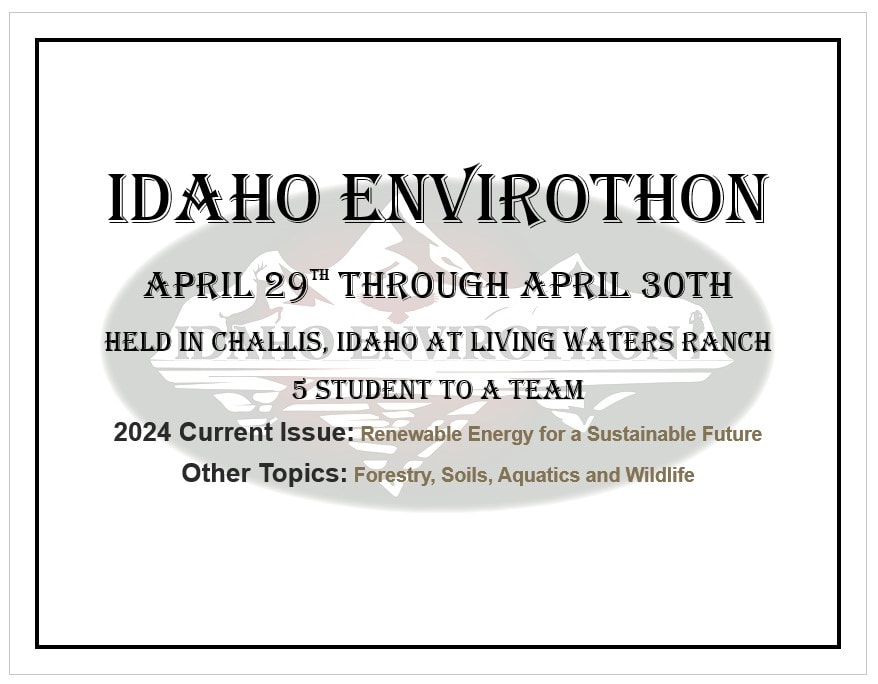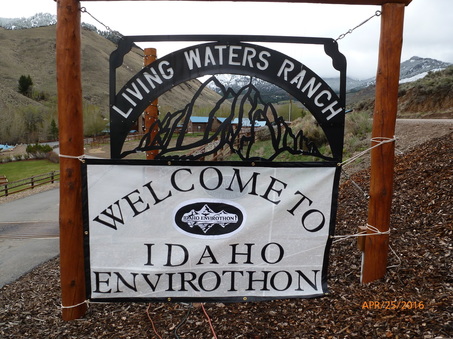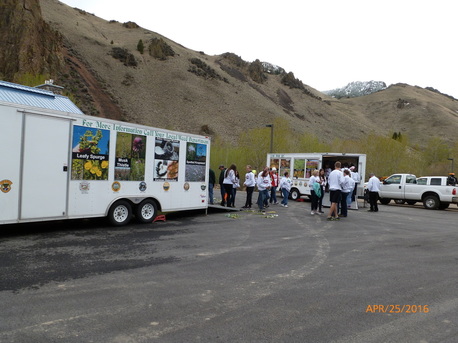2024 Idaho Envirothon Winners
1st Place- North Idaho STEM
2nd Place-Gooding #1
3rd Place- Pocatello #1
4th Place- Idaho City #2
5th Place- Malad
Highest Test Score Winner
Forestry -Gooding #1 and Malad
Wildlife- North Idaho STEM
Aquatics- North Idaho STEM
Soils- North Idaho STEM
Current Issue- Malad and Gooding #1
Outstanding Presentation- Malad
Rookie Team- Lost River
Spirit of Idaho Team- North Gem
2nd Place-Gooding #1
3rd Place- Pocatello #1
4th Place- Idaho City #2
5th Place- Malad
Highest Test Score Winner
Forestry -Gooding #1 and Malad
Wildlife- North Idaho STEM
Aquatics- North Idaho STEM
Soils- North Idaho STEM
Current Issue- Malad and Gooding #1
Outstanding Presentation- Malad
Rookie Team- Lost River
Spirit of Idaho Team- North Gem
www.livingwatersranch.org
2024 Current Issue: Renewable Energy for a Sustainable Future
2024 NCF-Envirothon
New YorkHobart and William Smith Colleges
Geneva, New York
Dates: July 28 - August 3, 2024
2024 NCF-Envirothon
New YorkHobart and William Smith Colleges
Geneva, New York
Dates: July 28 - August 3, 2024
In our modern world, energy touches almost every aspect of our lives. It lights our homes, transports our food, cleans our water, and fuels our cars, powers life-saving medical equipment, and so much more. The production and use of energy are deeply entwined with the economy, social and political issues, and the environment. The environmental, economic, and social outcomes of the choices being made about energy now will shape the future of our planet. Governmental policies, industry, and public opinion are shifting to embrace a sustainable future that includes renewable energy.
Today, power generation from renewable energy sources accounts for approximately one third of the total global output 1 . Signatories to the United Nations Convention on Climate Change agreed to work towards the goal of nearly 80% of the global power demand to be met by renewable sources by 2050 1. New York State is working to build a vibrant renewable energy industry covering all facets of the process from manufacturing to installation, and including technologies for solar, wind, biomass, and hydroelectric energy. New York State also has some of the most progressive energy and climate goals in the United States, including: the adoption of the Clean Energy Standard, the passage of a mandate for 70% of electricity in the state to be from renewable sources by 2030, the goal of achieving a 40% reduction in greenhouse gas emissions by 2030 (using 1990 levels as the baseline), and saving 185 trillion British Thermal units (Btus) in end-use energy by 2030 through greater efficiency (New York State Legislation: Climate Leadership and Community Protection Act).
Decisions about sustainable energy are not just made by politicians and corporations. Individuals can choose what energy practices to support and can advocate for the transition to renewables. New energy innovations are constantly transforming this emerging field, with technological developments in energy sources, production methods, and flexible delivery.
Students will learn about the different sources of renewable energy; the challenges facing the transition from traditional fossil fuels to renewables; the environmental, economic, and social impacts of energy consumption; and how individuals can affect change in their communities.
In our modern world, energy touches almost every aspect of our lives. It lights our homes, transports our food, cleans our water, and fuels our cars, powers life-saving medical equipment, and so much more. The production and use of energy are deeply entwined with the economy, social and political issues, and the environment. The environmental, economic, and social outcomes of the choices being made about energy now will shape the future of our planet. Governmental policies, industry, and public opinion are shifting to embrace a sustainable future that includes renewable energy.
Today, power generation from renewable energy sources accounts for approximately one third of the total global output 1 . Signatories to the United Nations Convention on Climate Change agreed to work towards the goal of nearly 80% of the global power demand to be met by renewable sources by 2050 1. New York State is working to build a vibrant renewable energy industry covering all facets of the process from manufacturing to installation, and including technologies for solar, wind, biomass, and hydroelectric energy. New York State also has some of the most progressive energy and climate goals in the United States, including: the adoption of the Clean Energy Standard, the passage of a mandate for 70% of electricity in the state to be from renewable sources by 2030, the goal of achieving a 40% reduction in greenhouse gas emissions by 2030 (using 1990 levels as the baseline), and saving 185 trillion British Thermal units (Btus) in end-use energy by 2030 through greater efficiency (New York State Legislation: Climate Leadership and Community Protection Act).
Decisions about sustainable energy are not just made by politicians and corporations. Individuals can choose what energy practices to support and can advocate for the transition to renewables. New energy innovations are constantly transforming this emerging field, with technological developments in energy sources, production methods, and flexible delivery.
Students will learn about the different sources of renewable energy; the challenges facing the transition from traditional fossil fuels to renewables; the environmental, economic, and social impacts of energy consumption; and how individuals can affect change in their communities.

Follow us on Instagram at envirothonidaho
To Learn more and watch videos about our Idaho Envirothon: click on the links below:
Thanks to Life on the Range and Clark County High School for their videos!
Thanks to Life on the Range and Clark County High School for their videos!
The Idaho Envirothon: is a hands-on environmental problem solving competition for high school aged students in the Idaho. Participating teams complete training and testing in five natural resource categories: Soils & Land Use, Aquatic Ecology, Forestry, Wildlife, and the current issue. Winning teams from each state and province advance to the North American Envirothon for an opportunity to compete for recognition, scholarships, and prizes.




